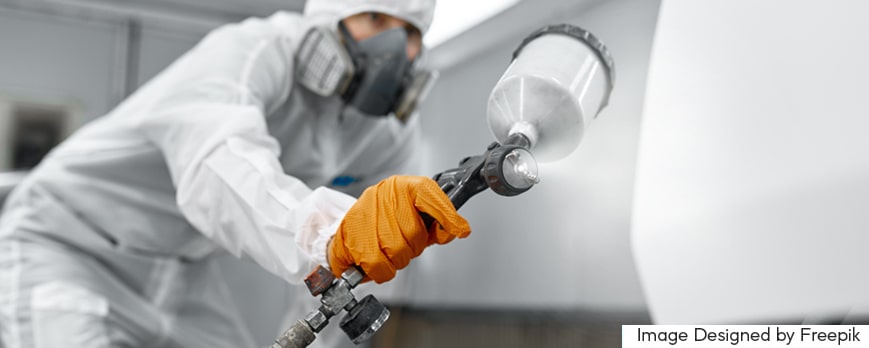Industrial paints are an essential component in various sectors, going beyond mere aesthetics to provide protection, durability, and functionality. These paints are designed to withstand extreme environmental conditions and prolong the lifespan of structures and equipment. In this article, we will explore how industrial paints are crucial in sectors like automotive, construction, the naval industry, and others.
Purpose of industrial paints
Industrial paints fulfill several key purposes that make them indispensable in industrial environments:
Corrosion protection: Metal surfaces exposed to the environment can corrode over time. Industrial paints act as a protective barrier against agents like water, salt, and chemicals.
Aesthetic and presentation: While the main function is protection, aesthetics are important, especially in sectors like automotive.
Durability and resistance: These paints are designed to withstand extreme conditions, such as high temperatures and abrasion, extending the lifespan of products.
Types of industrial paints
There are various types of industrial paints used based on the specific needs of the sector:
Epoxy paints: Ideal for highly corrosive environments.
Alkyd paints: Offer excellent adhesion and versatility.
Polyurethane paints: Known for their resistance to abrasion and chemicals.
Fire-retardant paints: Used to slow down the spread of fire in structures.
Industrial paints in the automotive industry
In the automotive sector, industrial paints play a crucial role in the protection and appearance of vehicles:
Chassis and component protection: Paints protect the metallic components of vehicles from oxidation and wear.
Enhancing vehicle aesthetics: Besides protection, paints improve the exterior appearance, which is vital for consumers.
Application processes: In automobile manufacturing, paints are applied using advanced methods that ensure uniform and durable coverage.
Use of industrial paints in construction
In construction, industrial paints are essential for protecting structures and buildings:
Protection of metal structures: Anti-corrosive paints protect bridges, towers, and other steel structures.
Exterior and interior paints: Different types of paints are used on facades and interiors to maintain durability and aesthetics.
Anti-corrosive paints in infrastructures: In bridges and other civil engineering projects, anti-corrosive paints are crucial to prevent structural damage.
Importance of industrial paints in the naval industry
The marine environment is one of the harshest, and industrial paints are vital for protecting ships and other naval structures:
Protection against saltwater: Paints protect against corrosion caused by saltwater and the marine environment.
Anti-slip paints for decks: Improve safety by reducing accidents on slippery decks.
Anti-fouling paints: These paints prevent marine organisms from adhering to the hull surface, improving the ship’s efficiency and performance.
Application of industrial paints in the aeronautical industry
In the aeronautical sector, industrial paints also play a fundamental role:
Paints resistant to friction and high pressure: Aircraft require coatings that resist the extreme pressures they are subjected to during flight.
Aerodynamic improvement: Paints help reduce air friction, improving aircraft performance.
Safety regulations: Paints must meet strict safety standards to ensure durability and resistance.
Industrial paints in the energy sector
Both conventional and renewable energy plants rely heavily on industrial paints:
Protection of oil and gas platforms: Structures exposed to corrosive environments, such as the sea, need durable coatings.
Protection of turbines and electrical equipment: Paints protect against mechanical wear and aggressive environments.
Thermal insulation and protection: Some industrial paints also offer thermal insulation, which is crucial in power plants.
Application processes for industrial paints
There are different techniques for applying industrial paints, depending on the surface and the environment:
Application techniques: Paint can be applied by immersion, spraying, or brush, depending on the surface.
Surface preparation: Before applying paint, it is crucial to prepare the surface to ensure adhesion.
Safety considerations: It is essential to follow safety regulations, as many of these products contain chemical compounds that require specialized handling.
Innovations in industrial paints
The industrial paint sector is constantly evolving, with new technologies improving their functionality:
Eco-friendly paints: Developed to reduce environmental impact.
Self-healing paints: Capable of regenerating their protective layer after damage.
Nanotechnology paints: Offer advanced properties, such as greater resistance to wear.
Maintenance and renewal of industrial paints
Proper maintenance is key to prolonging the lifespan of coated surfaces:
Importance of preventive maintenance: Regular inspections can detect problems before they become critical failures.
Repainting and renewal procedures: Periodic maintenance is necessary to ensure continued protection.
Inspection and monitoring: Constant inspection helps identify areas that require renewal or repair.
Economic advantages of using industrial paints
The use of industrial paints offers significant economic benefits:
Long-term cost reduction: Proper use of coatings reduces maintenance and repair costs.
Increased lifespan of equipment and structures: Prolong the life of industrial assets.
Prevention of accidents and damage: Protect both people and equipment, reducing the risk of accidents.
Environmental and sustainability considerations
Industrial paints also have an environmental impact:
Environmental impact: Industrial paints may contain volatile compounds that harm the environment.
Regulations and standards: Laws regulate the use of industrial paints to minimize their environmental impact.
Eco-friendly solutions: New formulas are designed to be more sustainable and reduce their ecological footprint.
Case studies and real examples
Offshore platform: The application of corrosion-resistant paints on offshore platforms has enabled more efficient and cost-effective maintenance.
Automotive industry: The application of advanced coatings has reduced the need for frequent part replacements in automobiles.
Future perspectives and trends
The future of industrial paints is shaping up with great innovations:
New technologies: Smart paints that adapt to environmental conditions are expected to dominate the market.
Automation: The use of robots for applying paints will improve precision and efficiency.
Growing demand for eco-friendly paints: With an increasing focus on sustainability, eco-friendly paints will continue to rise in popularity.
Conclusion
Industrial paints are a key element in the protection, preservation, and aesthetics of structures and equipment across multiple sectors. Their ability to enhance durability, safety, and efficiency, along with innovations in sustainability, ensures that their importance will continue to grow in the future.

